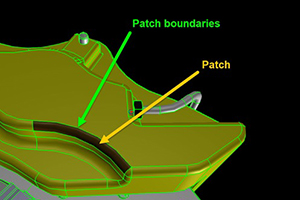Glossary
| Term | Definition |
|---|---|
| Assembly | A scene node that contains components. Assemblies define the hierarchy of the product structure. |
| Component | A behavior that is related to an occurrence. Examples are LOD groups and material assignations. |
| Decimation | A technique that is used to reduce the polygon density of a mesh by deleting vertices. |
| Entity | Any abstract object that is defined by an ID. In Data Engine, the entity is the base object. All manipulated objects are derived from entities. For example, parts, materials, and textures are entities. |
| Geometry | A collection of shapes. Geometries may be CAD geometries (BREP shapes) or mesh geometries (tessellated shapes). |
| Instance | An occurrence that points to a prototype occurrence. Use prototypes and instances to instantiate behavior. For example, you can instantiate parts, assemblies, and components. |
| Material | An entity that contains visual definitions. |
| Occurrence | A node in the product structure. In Unity, occurrences are referred to as GameObjects. |
| Part | A part occurrence that can be selected individually in a scene. Part occurrences contain geometry information. In Unity, parts are referred to as renderers. |
| Patch | A CAD face or surface that is limited by spline curves. Patches have no strict equivalent in Unity. The concept of submesh in Unity is the closest. |
| Patch boundary | A non-discontinuous patch border or edge. |
| Polygon | A triangle, a quadrangle, or another simple convex polygon (n-gon). In Unity, all polygons are triangles. |
| Polygon mesh | A collection of vertices, edges, and faces. |
| Product structure | The scene hierarchy. In Unity, the product structure is referred to as the hierarchy of GameObjects. |
| Prototype | An occurrence that can be referenced from other occurrences. Occurrences that point to a prototype are instances. Use prototypes and instances to instantiate behavior. |
| Tessellation | A modeling method for surfaces and solids. Tessellation is used to represent 3D objects as a collection of triangles or other types of polygons. This method turns all surfaces, whether curved or straight, into polygons. You can tessellate models during creation or in real time during rendering. The more triangles on a surface, the more realistic the rendering, but the more computation is required. Read more about meshes and CAD. |